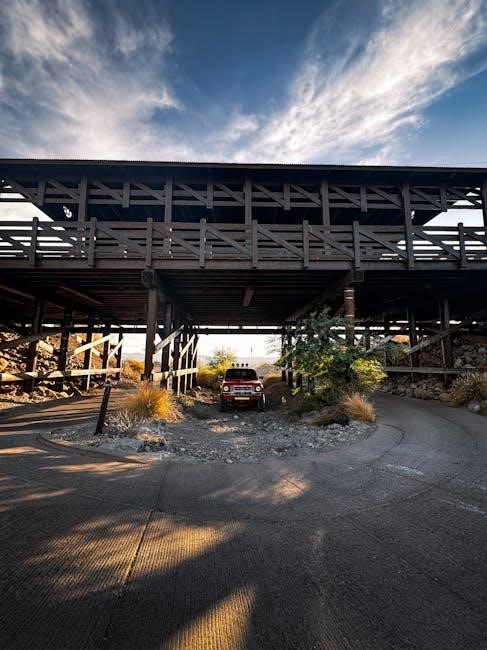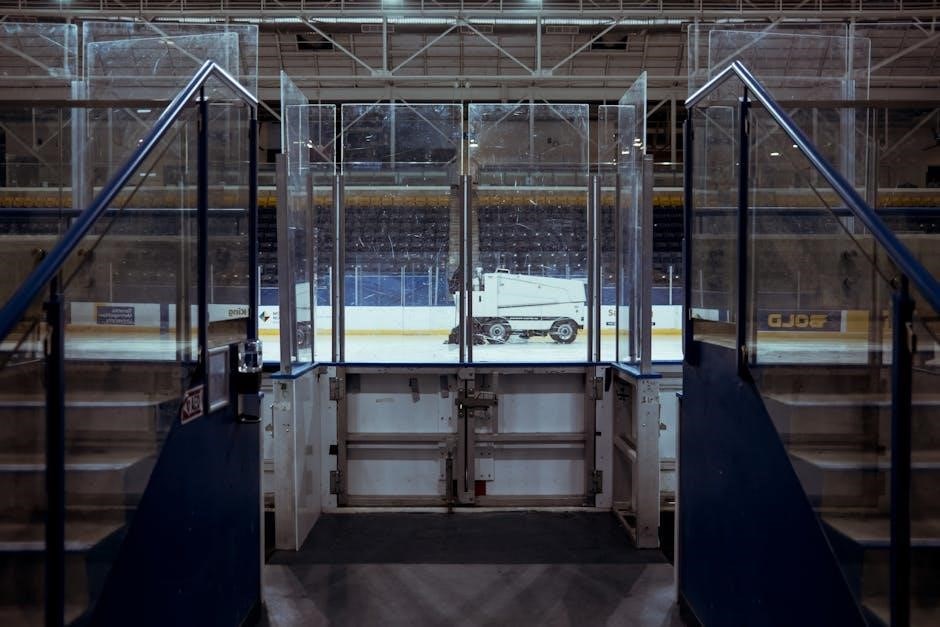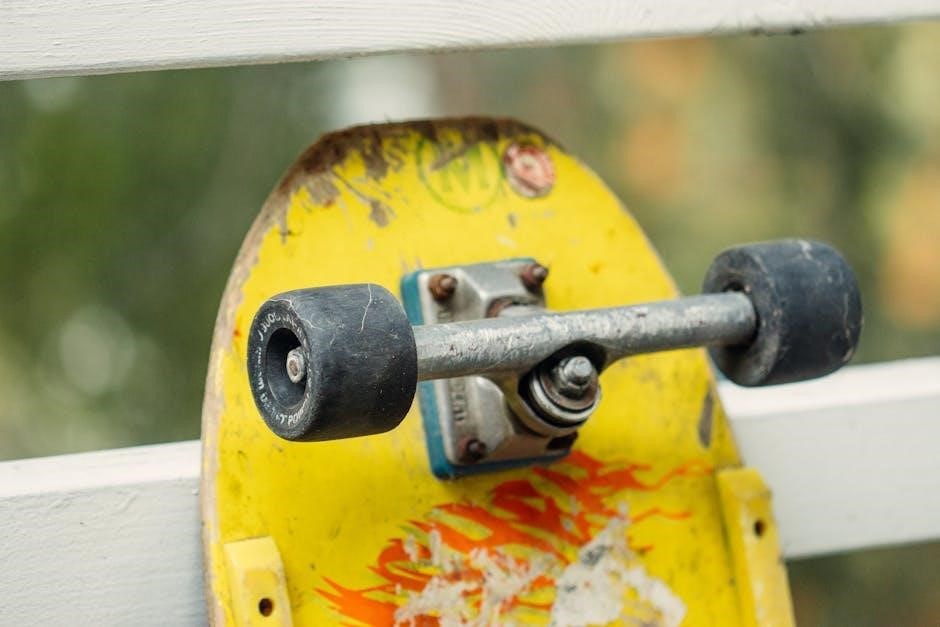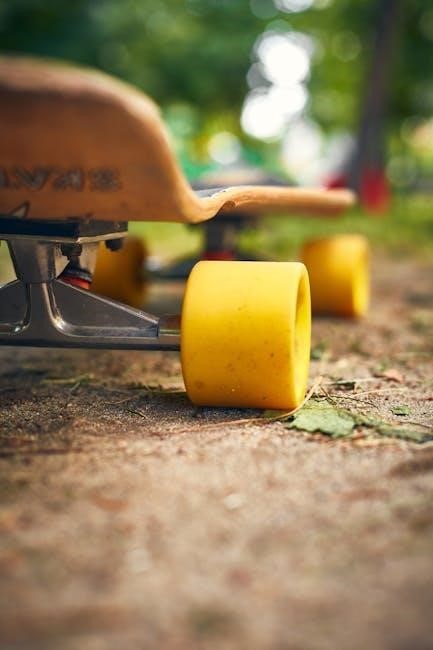
Choosing the right truck size is crucial for optimal skateboard performance and comfort. This guide covers essential factors like deck width, skating style, and personal comfort to help you make an informed decision.
Why Truck Size Matters
Truck size is crucial for stability, control, and overall performance. Properly sized trucks ensure your skateboard handles well, whether cruising or performing tricks. They affect turning ability and compatibility with wheels and bearings, impacting both comfort and durability. Choosing the right size enhances your skating experience and safety. Always match truck width to deck width for optimal balance and responsiveness, ensuring compatibility with your skating style and preferences.
Understanding Truck Measurements
Truck size is determined by width, which must align with your skateboard deck for optimal performance. Proper measurements ensure stability, control, and compatibility with wheels and bearings, enhancing your skating experience and safety.
How Truck Width is Measured
Truck width is measured across the hanger, from one end to the other, using a ruler or caliper. Proper sizing is critical, as it directly impacts stability and control. A 5.0 truck, for example, matches a 7.75″ deck width, ensuring optimal performance. Always refer to the manufacturer’s sizing chart for accuracy, as variations exist between brands. This ensures the trucks align perfectly with your deck, providing the best balance and responsiveness for your skating style and comfort level.
Standard Truck Sizes and Their Meanings
Standard truck sizes range from 4.0 to 6.0 inches, with each size corresponding to specific deck widths. For example, a 5.0 truck matches a 7.75″ deck, while a 6.0 truck pairs with an 8.5″ deck. Smaller trucks (4.0-5.0) are ideal for narrower decks and street skating, offering tighter turns. Larger trucks (5.5-6.0) suit wider decks, providing stability for cruising or downhill. Each size balances maneuverability and stability, catering to different skating styles and preferences. Always consult a truck size chart for precise compatibility.
Factors Influencing Truck Size Choice
Truck size choice depends on rider weight, height, skating style, and personal comfort. Larger riders may prefer wider trucks for stability, while smaller riders opt for narrower setups.
Rider Weight and Height Considerations
A rider’s weight and height significantly impact truck size selection. Heavier skaters benefit from wider trucks for added stability, while lighter riders may find narrower trucks more maneuverable. Height also plays a role, as taller individuals might prefer wider setups to match their stance. Balancing these factors ensures optimal control and comfort, allowing riders to perform at their best regardless of their size or skating style.
Skating Style and Discipline
Skating style and discipline greatly influence truck size choice. Street skaters often prefer narrower trucks for agility and tricks, while cruisers and downhill riders opt for wider trucks for stability. Freestyle skaters may favor mid-width trucks for versatility. Understanding your discipline helps tailor your setup to meet performance needs, ensuring responsiveness and control in specific skating scenarios. Matching your style with the right trucks enhances your overall skating experience and maneuverability.

Measuring Your Skateboard Deck
Measuring your skateboard deck accurately is essential for choosing the right truck size. Place a ruler or tape measure across the deck’s widest point to determine its width. This measurement directly corresponds to the appropriate truck width, ensuring proper fit and performance. Accurate measurement is crucial for optimal handling and stability, so double-check your measurements for consistency before selecting your trucks.
How to Accurately Measure Deck Width
To accurately measure your skateboard deck width, place a ruler or tape measure across the deck’s widest point, typically between the outer edges of the truck mounting holes. Ensure the ruler is flat and aligned straight for precise measurement. Note the width in inches, as this will directly determine the appropriate truck size. Double-check your measurement to avoid errors, as accurate sizing is critical for proper truck compatibility and optimal performance. Always measure at the widest point for the most accurate results.
Matching Deck Width to Truck Size
To ensure optimal performance, it’s crucial to match your skateboard deck width with the appropriate truck size. Measure your deck width accurately, typically across the widest point. A general rule of thumb is to select trucks that closely align with your deck’s width. For instance, a 7.75-inch deck often pairs well with a 5.0-inch truck. Consulting a truck size chart specific to your chosen brand, such as Independent or Grind King, will provide precise measurements. Additionally, consider personal factors like height, weight, and skating style. Taller or heavier riders may benefit from wider trucks for stability, while those focused on maneuverability might opt for narrower ones. For downhill skating, reverse kingpin trucks are recommended for enhanced stability and control. Always refer to the manufacturer’s sizing guide to ensure compatibility and the best skating experience.
Truck Size Chart
A truck size chart helps match deck width to truck width, ensuring proper fit and performance. Common pairings include 7.75-inch decks with 5.0-inch trucks. Always refer to brand-specific charts for precise sizing.
Deck Width to Truck Size Conversion
Deck width directly influences truck size selection. A 7.75-inch deck typically pairs with 5.0-inch trucks, while an 8.5-inch deck matches 6.0-inch trucks. Use the following guide:
- 7.0″-7.75″ decks = 4.0″-5.0″ trucks
- 8.0″-8.5″ decks = 5.25″-6.0″ trucks
- 8.6″-9.0″ decks = 6.25″-7.0″ trucks
Always consult brand-specific charts for precise sizing, as variations exist. Proper sizing ensures optimal performance and stability.
Popular Truck Sizes for Common Deck Widths
For most skateboards, a 7.75″-8.0″ deck pairs well with 5.0″-5.25″ trucks, offering a balanced feel. Wider decks (8.25″-8.5″) often use 6.0″ trucks for stability. Narrow decks (7.0″-7.5″) work best with 4.0″-4.5″ trucks, providing easier maneuverability. Popular brands like Independent offer size-specific options, ensuring compatibility. Always match truck width to deck width for optimal performance and control, as proper sizing enhances both stability and responsiveness for skaters of all levels and styles.

Popular Truck Brands and Their Sizes
Independent Trucks offers sizes like 129, 139, and 149, catering to various deck widths. Royal Trucks provides lightweight options in sizes 3.5″ to 5.5″. Thunder Trucks and Venture also offer durable choices, ensuring compatibility with different skating styles. Each brand tailors its sizing to specific needs, from street skating to downhill racing, making it essential to consult brand-specific charts for the perfect fit. Matching trucks to your deck ensures optimal performance and comfort.
Independent Trucks Size Guide
Independent Trucks offers a wide range of sizes, including 109, 129, 139, 149, and 169. These sizes correspond to deck widths, ensuring optimal performance and stability. For example, a 7.75″ deck pairs well with 129 trucks, while an 8.5″ deck matches 149 trucks. Independent Trucks are known for their durability and versatility, catering to various skating styles. Always consult their size chart to find the perfect fit for your setup, ensuring enhanced control and maneuverability.
Other Notable Brands and Their Sizing
Besides Independent, brands like Grind King and others offer unique sizing options. Grind King trucks are known for their strength and compatibility with wider decks, often recommended for heavier skaters. Other brands may have specific sizing charts tailored to their designs. Always refer to the brand’s official sizing guide to ensure compatibility with your deck width and skating style, as sizes can vary slightly between brands, affecting performance and overall ride quality.
Reverse Kingpin Trucks
Reverse kingpin trucks feature a unique design, making them ideal for downhill skating and high-speed maneuvers. They provide exceptional stability and control, favored by skaters seeking precision at higher speeds.
What Are Reverse Kingpin Trucks?
Reverse kingpin trucks are a type of skateboard truck designed with the kingpin located behind the axle, creating a more rigid and stable setup. This design enhances lean and turning capabilities, making them ideal for downhill skating and high-speed maneuvers. They provide superior control and responsiveness, favored by skaters seeking precision and stability at faster speeds. Their unique geometry allows for better weight distribution, enabling sharper turns and smoother transitions.
Best Uses for Reverse Kingpin Trucks
Reverse kingpin trucks are ideal for downhill skating, offering exceptional stability and control at high speeds. Their rigid design excels in carving and cruising, providing precise turns and smooth transitions. Skaters seeking responsiveness and durability for aggressive riding styles benefit most from these trucks. They are also popular among those who prioritize speed and maneuverability, making them a top choice for performance-oriented skaters. Their unique geometry ensures optimal handling in demanding conditions, enhancing overall skating efficiency and confidence.
Wheels and Bearings Compatibility
Wheel size impacts truck choice, as larger wheels require wider trucks for stability. Ensure bearings are compatible with both wheels and trucks for smooth performance.
How Wheel Size Affects Truck Choice
Wheel size significantly impacts truck choice, as it affects stability and maneuverability. Larger wheels (58mm+) require wider trucks for better balance, while smaller wheels (50mm-) suit narrower trucks for tighter turns. The truck’s hanger width must align with the wheel size to prevent wheel bite and ensure proper clearance. Riders should match their wheel size to their skating style—cruisers prefer larger wheels with wider trucks, while street skaters opt for smaller setups. Compatibility ensures optimal performance and control.
Bearing Sizes and Truck Compatibility
Bearing sizes are standardized, with most skateboards using 608 bearings (8mm diameter). Ensure your bearings fit your trucks by checking the manufacturer’s specifications. While most trucks accommodate standard bearings, some specialized models may require specific sizes. Proper compatibility ensures smooth performance and prevents damage. Always verify compatibility before purchasing to avoid issues with fitment or functionality. This step is crucial for maintaining optimal skateboard performance and longevity.

Personal Preferences and Comfort
Personal preferences, such as riding style, weight, and deck width, play a significant role in choosing truck size. Ensure your setup offers comfort and control for optimal performance.
Weight Distribution and Balance
Weight distribution and balance are critical for stability and control. Properly sized trucks ensure even weight distribution, preventing instability. Riders with higher weight or aggressive styles may prefer wider trucks for better support. Narrower trucks suit lighter riders, enhancing maneuverability; Incorrect sizing can lead to instability or difficulty in turning. Ensure your truck size aligns with your weight and skating style for optimal balance and performance. This balance is key to a smooth and responsive skateboarding experience.
Customizing Your Setup for Comfort
Customizing your skateboard setup enhances comfort and performance. Adjusting truck tightness can provide the desired responsiveness. Looser trucks offer easier turning, while tighter trucks improve stability at higher speeds. Wheel size and hardness also play a role; softer wheels absorb shocks better, while harder wheels offer faster rolls. Personalizing these components ensures a setup tailored to your skating style and preferences, making every session more enjoyable and tailored to your needs.
Common Mistakes to Avoid
Common mistakes include mismatching truck size to deck width and ignoring skating style. Correct sizing ensures stability and optimal performance for a better skating experience.
Incorrectly Sizing Trucks for Deck Width
Incorrectly sizing trucks for deck width is a common mistake that affects performance. Narrow trucks on a wide deck can cause instability, while wide trucks on a narrow deck may look awkward and hinder maneuverability. Always match truck width to deck width for optimal stability and control. For example, a 7.75″ deck pairs well with a 5.0″ truck. Check brand-specific size charts and consider your skating style to avoid this error. Proper sizing ensures better balance and responsiveness.
Neglecting Personal Skating Style
Neglecting your skating style can lead to poor truck choices. Cruisers may prefer wider, stable trucks, while street skaters need narrower, agile ones. Downhill riders benefit from reverse kingpin trucks for better stability and turning. Consider your weight and height as well—larger riders may need sturdier setups. Always match truck size to your deck width and consult brand-specific charts to ensure compatibility. Personalizing your setup enhances performance and comfort, making your skating experience more enjoyable and tailored to your needs. Proper sizing prevents imbalance and improves responsiveness.
Assembling Your Skateboard
Assembling your skateboard requires careful alignment and installation of trucks, ensuring they fit securely to the deck. Proper tightening and alignment are crucial for stability and control.
Step-by-Step Truck Installation
Position the trucks on the skateboard deck, ensuring they are centered and aligned with the mounting bolts. Mark the bolt holes on the deck for accurate drilling. Drill pilot holes to prevent splitting the wood. Mount the trucks using the provided bolts, tightening them evenly. Ensure the trucks are securely fastened but not overtightened. Finally, test the board to confirm stability and proper alignment for optimal performance.
Tightening and Adjusting Trucks
Tighten the kingpin bolt to secure the trucks in place, ensuring they are snug but not over-tightened. Adjust the pivot cups to achieve the desired turning sensitivity. Loosen the kingpin slightly for a more responsive ride or tighten it for stability. Fine-tune the trucks by tightening or loosening the baseplate bolts to customize the lean and balance. Regularly check and adjust the trucks to maintain optimal performance and responsiveness.
Maintenance and Upkeep
Regular cleaning and lubrication of moving parts maintain performance and prevent wear. Inspect trucks for worn components and replace them as needed to ensure safety and optimal function.
Cleaning and Lubricating Trucks
Regular maintenance ensures trucks perform optimally and last longer. Use a soft brush or cloth to remove dirt and grime from axles and kingpins. Lubricate pivot cups and bushings with silicone-based lubricant to reduce friction. Avoid using harsh chemicals, as they can damage components. For bearings, clean with a solvent and re-lubricate after drying. Proper care prevents rust and keeps your trucks running smoothly. Regular cleaning and lubrication are essential for maintaining responsiveness and stability while skating.
When to Replace Trucks
Replace trucks when they show significant wear or damage. Look for worn-out bushings, stripped kingpins, or cracked hangers. If the trucks no longer respond smoothly or feel unstable, it’s time to upgrade. Rust or corrosion on axles or bolts is another sign for replacement. Upgrade your trucks every 6-12 months if you skate frequently. Worn trucks can affect performance and safety, so don’t wait until they fail completely. New trucks ensure better stability, turning, and overall skating experience.
Budget Considerations
Budget plays a key role in choosing trucks. High-end trucks offer durability and performance, while entry-level options provide affordability without compromising basic functionality for casual skaters.
High-End vs. Entry-Level Trucks
High-end trucks are built with premium materials, offering superior durability, smoother turning, and better weight distribution. They are ideal for serious skaters seeking top performance. Entry-level trucks, while more affordable, still provide reliable performance for casual skating. Brands like Independent offer high-quality options at various price points, ensuring both durability and value. It’s essential to balance budget with skating frequency and style to choose the right option.
Cost-Effective Brand Options
Affordable truck options are available from brands like Grind King and other notable manufacturers. These brands offer durable construction and reliable performance at lower prices, making them ideal for skaters on a budget. They provide excellent value without compromising essential features, ensuring a smooth skating experience. These cost-effective options are perfect for casual skaters or those looking to upgrade without breaking the bank.

Future-Proofing Your Setup
Investing in versatile trucks ensures your setup remains relevant as your skills evolve. Choose models that adapt to various skating disciplines and deck widths for long-term performance.
Choosing Versatile Trucks
Selecting versatile trucks ensures your skateboard adapts to different skating styles and terrains. Opt for trucks with adjustable kingpins to customize turning tightness. Consider trucks compatible with various wheel sizes for flexibility in performance. Durable materials and robust construction ensure longevity. Versatile trucks are ideal for skaters exploring multiple disciplines, from street to downhill. They offer the freedom to experiment without frequent upgrades, making them a practical choice for skaters seeking adaptability and reliability in their setup.
Upgrading as Skills Improve
As your skills advance, consider upgrading your trucks to match your evolving needs. Higher-end trucks offer improved durability, responsiveness, and precision. Upgrading to lighter materials can enhance maneuverability, while sturdier trucks provide stability for more aggressive riding. Stay informed about new technologies and brands to find the best fit for your progression. Upgrading strategically ensures your setup keeps pace with your growing abilities, whether you’re mastering tricks or transitioning to more challenging terrains and speeds.
Selecting the right truck size enhances your skateboarding experience, ensuring better control and comfort. Match your deck width and skating style for optimal performance.
Key Takeaways
- Proper truck size significantly impacts skateboard performance and comfort.
- Match truck width to deck width for optimal stability and control.
- Consider skating style, weight, and personal preference when choosing trucks.
- Reverse kingpin trucks are ideal for downhill due to enhanced stability.
- Consult size charts and seek expert advice for the best fit.
Final Tips for Choosing the Right Trucks
- Test different sizes if possible to ensure comfort and performance.
- Consider durability based on your skating frequency and style.
- Balance stability and maneuverability to suit your preferences.
- Seek advice from experienced skaters or professionals.
- Check brand reputations for quality and reliability.
Frequently Asked Questions
- Why is truck size important? Proper sizing ensures stability, control, and optimal performance.
- How do I match trucks to my deck? Measure deck width and choose trucks with a corresponding size.
- Do my weight and height matter? Yes, they influence truck size selection for comfort and stability.
Common Questions About Truck Size
- What truck size should I choose? Match your deck width to the truck width for optimal performance.
- Does deck width matter? Yes, it directly impacts stability and control.
- How do I know if I need wider trucks? If your trucks are too narrow, your board may feel unstable.
- Are there size recommendations for my weight? Yes, heavier riders often prefer wider, sturdier trucks.
Addressing Reader Concerns
Readers often ask about balancing truck size with personal comfort and skating style. Ensure your trucks align with your deck width for stability. Heavier riders may prefer wider trucks, while cruisers might opt for reverse kingpin trucks for better lean. Always consult brand size charts and consider upgrading as your skills improve. Remember, proper sizing enhances performance and safety, so take the time to research and test different setups. Your comfort and skating style should guide your final decision, ensuring a smooth and enjoyable ride.